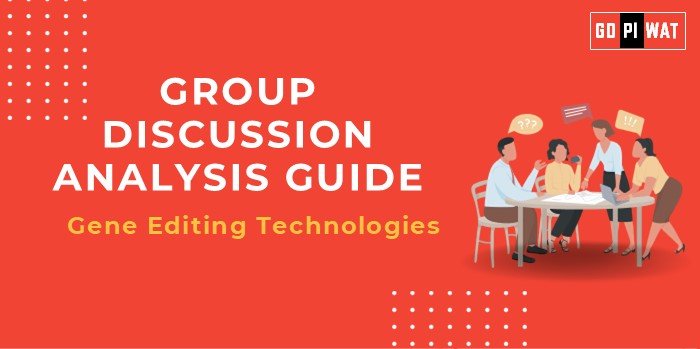📋 Group Discussion Analysis Guide: The Ethics and Applications of Gene Editing
🌐 Introduction to the Topic
- 🔍 Opening Context: “Gene editing technologies, like CRISPR, represent a revolutionary leap in medical science, offering the potential to eliminate genetic diseases. But their use raises profound ethical and societal questions.”
- 📖 Topic Background: Gene editing tools such as CRISPR-Cas9 have enabled precise modification of DNA. The technology, heralded since its discovery in 2012, has seen applications ranging from agriculture to experimental medicine. The global scientific community continues to grapple with the implications of editing human germline cells, which can permanently alter future generations.
📊 Quick Facts and Key Statistics
– 🧬 CRISPR Discovery Year: 2012 – Revolutionized genetic engineering possibilities.
– 🩺 Genetic Diseases Affected: Over 10,000 known genetic disorders could potentially be targeted.
– 💰 Global CRISPR Market Size: $3.6 billion in 2023 – Reflecting its broad applications and growing investment.
– 🎯 Success Rate in Lab Studies: Over 80% precision in certain genetic modifications.
– ⚖️ Ethical Opposition: 75% of surveyed ethicists express concerns about germline editing (2022, Bioethics Journal).
– 🩺 Genetic Diseases Affected: Over 10,000 known genetic disorders could potentially be targeted.
– 💰 Global CRISPR Market Size: $3.6 billion in 2023 – Reflecting its broad applications and growing investment.
– 🎯 Success Rate in Lab Studies: Over 80% precision in certain genetic modifications.
– ⚖️ Ethical Opposition: 75% of surveyed ethicists express concerns about germline editing (2022, Bioethics Journal).
🤝 Stakeholders and Their Roles
- 🔬 Scientists: Drive innovation and refine safety measures.
- 👩⚕️ Medical Practitioners: Advocate for practical applications to improve patient outcomes.
- ⚖️ Ethics Committees: Evaluate the moral implications of human DNA modification.
- 🏛️ Governments: Regulate research and its applications.
- 👥 Patients: Direct beneficiaries of genetic therapies.
- 📢 Public Advocacy Groups: Highlight concerns about inequality and misuse.
🏆 Achievements and Challenges
✨ Achievements:
- 🩸 Sickle Cell Anemia Trials: Positive results in over 90% of patients in 2023.
- 🧠 Preventing Huntington’s Disease: Breakthrough animal studies in 2022.
- 🌾 Agriculture Impact: Enhanced crop resistance and yields.
- 🧪 Cancer Research: Development of personalized gene-based therapies.
⚠️ Challenges:
- ❓ Ethical Concerns: Fear of “designer babies” and societal inequality.
- 🔍 Technical Risks: Off-target effects causing unintended mutations.
- 🌐 Global Regulation Gap: Varying laws across countries complicate progress.
🌍 Global Comparisons:
– China: Leading clinical trials but criticized for ethical lapses (e.g., CRISPR babies scandal in 2018).
– Germany: Stringent laws balancing innovation and ethics.
📌 Case Studies:
– U.S.: FDA-approved CRISPR-based sickle cell therapy in 2023.
– U.K.: Advanced research in preventing mitochondrial diseases.
🧠 Structured Arguments for Discussion
- ✅ Supporting Stance: “Gene editing holds unparalleled promise for eradicating debilitating genetic disorders, such as cystic fibrosis and muscular dystrophy.”
- ❌ Opposing Stance: “The risks of unintended mutations and ethical concerns about societal misuse outweigh the potential benefits.”
- ⚖️ Balanced Perspective: “While gene editing could save millions from suffering, its applications must be carefully regulated to prevent misuse and ensure ethical compliance.”
🎯 Effective Discussion Approaches
- 📜 Opening Approaches:
- 📈 Statistical Insight: “With over 10,000 genetic disorders identified, gene editing offers hope for millions worldwide.”
- ⚖️ Ethical Debate: “Can we justify altering human DNA for potential societal benefit despite ethical gray areas?”
- 🔍 Counter-Argument Handling:
- Acknowledge risks but highlight safety advancements.
- Refer to regulatory measures and existing ethical frameworks.
🔍 Strategic Analysis of Strengths and Weaknesses
- 💪 Strengths: Potential to cure diseases, reduce healthcare costs, enhance quality of life.
- ⚠️ Weaknesses: Ethical dilemmas, potential misuse, and technical imperfections.
- 🚀 Opportunities: Collaboration on global regulations, furthering disease research.
- ⚡ Threats: Public mistrust and uneven access to technology.
🎓 Connecting with B-School Applications
- 🌟 Real-World Applications: Exploring gene editing in health-tech entrepreneurship or pharmaceutical innovation.
- ❓ Sample Interview Questions:
- “How can gene editing reshape healthcare systems worldwide?”
- “What ethical concerns would you prioritize as a policy maker?”
- 💡 Insights for Students:
- Research collaborations, balancing innovation with ethical considerations, exploring biotech startups.


